
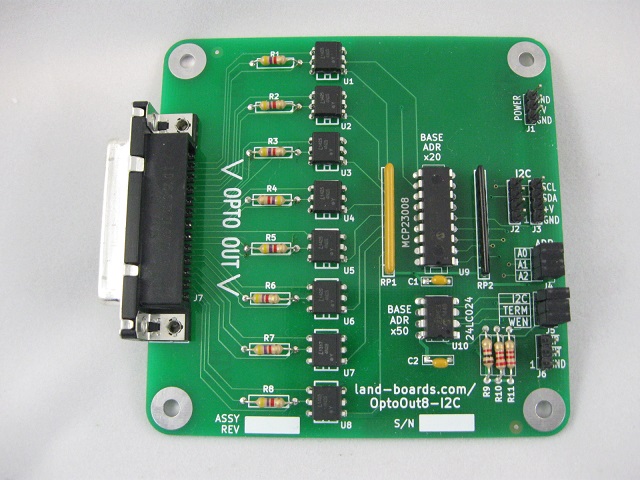
Features
- Eight optically-isolated output channels on card
- MCP23008 I2C Parallel I/O
- I2C (Two Wire interface)
- 100/400 KHZ operation
- Jumper selectable 2.2K Ohm terminators
- 3-bit address (Jumper selectable) - Up to 8 boards
- Single 4-pin host interface connector (Ground, Power, Clock, Data)
- 24LC024 ODAS Personality EEPROM
- pid = 5
- Write protect jumper
- 5V operation
- Compatible with Arduino, Raspberry Pi, BeagleBone Black
- DB-25F connector for rugged applications
- 95x95mm form factor
- (4) 6-32 mounting holes - one on each corner
MCP23008 Block Diagram
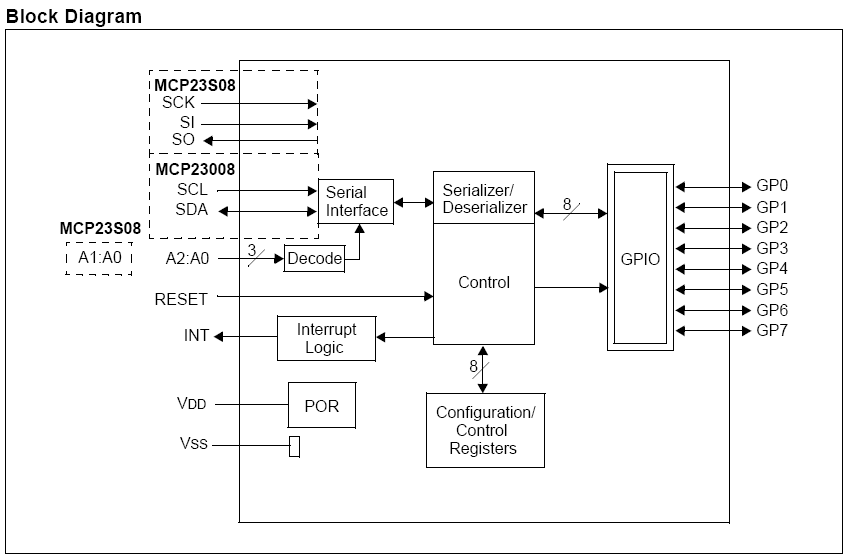
Optocoupler Performance

- Current Transfer ratio curve
- 25mA sink/source capability per I/O
- Maximum current out of VSS pin = 150 mA
- Maximum current into VDD pin = 125 mA
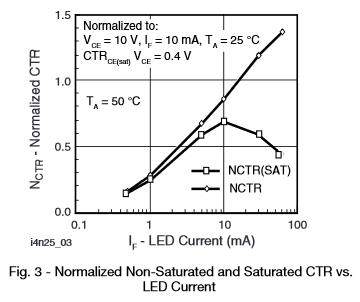
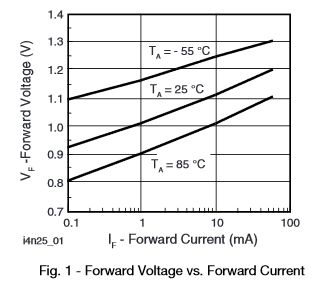
- Output transistor capacitance


| Vcc
|
5.000
|
V
|
3.300
|
V
|
| Vf LED
|
1.200
|
V
|
1.200
|
V
|
| Res ser
|
330.000
|
Ohms
|
330.000
|
Ohms
|
| If LED
|
11.515
|
mA
|
6.364
|
mA
|
| CTR (min)
|
0.500
|
A/A
|
0.500
|
A/A
|
| Iout
|
5.758
|
mA
|
3.182
|
mA
|
| All pins Low
|
8
|
|
8
|
|
| I(Vss pin)
|
92.121
|
mA
|
50.909
|
mA
|
| I Max (Vss)
|
150.000
|
|
150.000
|
|
| Loading
|
61.41%
|
|
33.94%
|
|
Connectors
J1 - Power
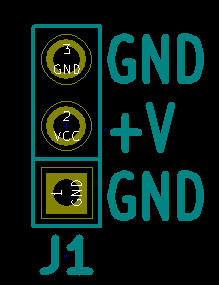
J2-J3 - I2C
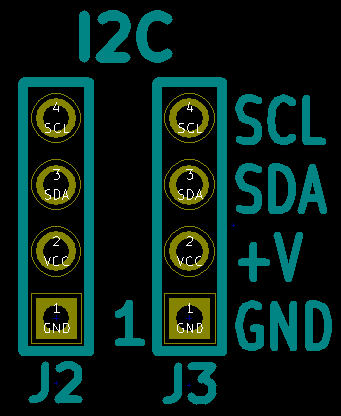
J4 - I2C Address Select Jumpers
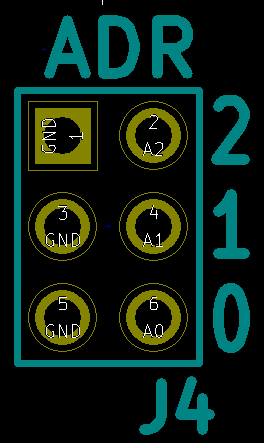
J5 - I2C Termination Jumpers
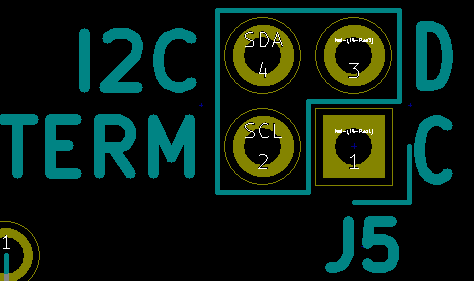
J6 - Card Present/Interrupt
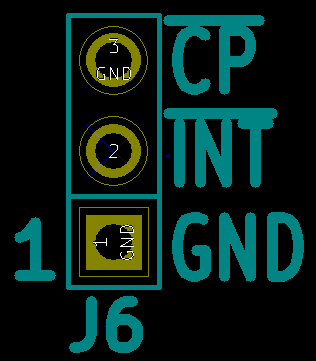
- GND
- INT
- CP - Card present (pulled low)
J7 - I/O connector
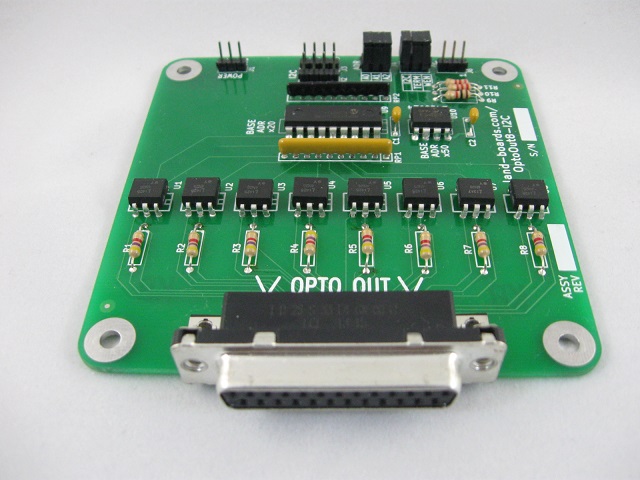
DB-25 Female
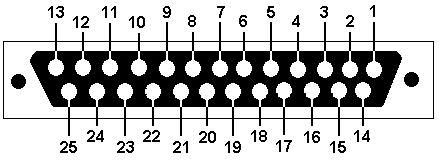

| OptoOut
|
OptoOut
|
DB25RIB
|
DIGIO32
|
DB37RIB
|
|
OptoOut
|
OptoOut
|
DB25RIB
|
DIGIO32
|
DB37RIB
|
| Pin
|
Descr
|
Pin_26
|
Descr
|
Pin_40
|
|
Pin
|
Descr
|
Pin_26
|
Descr
|
Pin_40
|
| 1
|
S7
|
1
|
C1PA7
|
18
|
|
14
|
V7
|
2
|
C0PB7
|
20
|
| 2
|
G7
|
3
|
C0PA7
|
35
|
|
15
|
S6
|
4
|
C1PA6
|
16
|
| 3
|
V6
|
5
|
C0PB6
|
22
|
|
16
|
G6
|
6
|
C0PA6
|
33
|
| 4
|
S5
|
7
|
C1PA5
|
14
|
|
17
|
V5
|
8
|
C0PB5
|
24
|
| 5
|
G5
|
9
|
C0PA5
|
31
|
|
18
|
S4
|
10
|
C1PA4
|
12
|
| 6
|
V4
|
11
|
C0PB4
|
26
|
|
19
|
G4
|
12
|
C0PA4
|
29
|
| 7
|
S3
|
13
|
C1PA3
|
10
|
|
20
|
V3
|
14
|
C0PB3
|
28
|
| 8
|
G3
|
15
|
C0PA3
|
27
|
|
21
|
S2
|
16
|
C1PA2
|
8
|
| 9
|
V2
|
17
|
C0PB2
|
30
|
|
22
|
G2
|
18
|
C0PA2
|
25
|
| 10
|
S1
|
19
|
C1PA1
|
6
|
|
23
|
V1
|
20
|
C0PB1
|
32
|
| 11
|
G1
|
21
|
C0PA1
|
23
|
|
24
|
S0
|
22
|
C1PA0
|
4
|
| 12
|
V0
|
23
|
C0PB0
|
34
|
|
25
|
G0
|
24
|
C0PA0
|
21
|
| 13
|
N/C
|
25
|
|
|
|
|
|
26
|
|
|
Design Validation/First Article Test
Pass Count = 17977, Fail Count = 0
- Runs ODAS Card Test Software on Arduino Nano
- Loopback cables
- Cable connects to DB-25 and NANO-BKOUT pins
- USB running puTTY
- Menu driven
- Auto-detect card if test has been run before
Checking EEPROM for board type...Detected OptoIn8-I2C board
R=Read EEPROM, W=Write EEPROM, T=Test DIGIOs, L=Loop Test, B=Bounce LEDs
- Presents card type list for un-programmed EEPROMs
Checking EEPROM for board type...Company Mismatch
Select the board type
1 - DIGIO16-I2C board
2 - DIGIO-128 board
3 - OptoIn8-I2C board
4 - OptoOut8-I2C board
5 - DIGIO32-I2C board
6 - PROTO16-I2C board
7 - ODAS-PSOC5 board
8 - TBD board
9 - TBD board
Select board >
Select board > 3
Writing EEPROM
Initializing eep buffer
len of buffer=96
reading block
Family=ODAS
Company=land.boards.com
OptoIn8-I2C failed HIGH on bit 1
Read back on 1
OptoIn8-I2C failed HIGH on bit 2
Read back on 2
OptoIn8-I2C failed HIGH on bit 4
Read back on 4
OptoIn8-I2C failed HIGH on bit 8
Read back on 8
OptoIn8-I2C failed HIGH on bit 16
Read back on 16
OptoIn8-I2C failed HIGH on bit 32
Read back on 32
OptoIn8-I2C failed HIGH on bit 64
Read back on 64
OptoIn8-I2C failed HIGH on bit 128
Read back on 128
Loopback Test PASS = 0, FAIL = 1
- Pass Checking EEPROM for board type...Detected OptoIn8-I2C board
R=Read EEPROM, W=Write EEPROM, T=Test DIGIOs, L=Loop Test, B=Bounce LEDs
Loopback Test PASS = 1, FAIL = 0
Production Tests
Test Station Theory of Operations
- Test Station controls/read the Opto outputs via the DIGIO32 card in the Test Station
- Puts out 8 bits on OptoOut8-I2C card
- Reads the 8 bits on DIGIO32 card
- There are three lines per Channel that need to be connected:
- Ground (Gx), Power (Vx), Open Collector Output (Sx)
- If the LED is not being driven, the Open Collector output will be pulled up
- Wire Grounds to Digio32 channels 0-7
- Wire Powers to Digio32 channels 8-15
- Wire Signals to Digio32 channels 16-23
- Resistors can be checked by setting the Power line high and checking the OC outputs
- OptoOut8-I2C card is stimulated by writing to its I2C interface
- Verifies that the Optos work
Test Station Set-up
- Uses ODAS Test Station V2
- Unit Under Test (UUT)
- Attach Host Computer USB to the Arduino NANO on the Test Station
- Run puTTY on the Host Computer
EEPROM Programming
- First time the card is tested
- Enter E to access EEPROM menu
- Enter W to select the card
Select the board type
1 - DIGIO16-I2C board
2 - DIGIO-128 board
3 - OptoIn8-I2C board
4 - OptoOut8-I2C board <<< Select 4
5 - DIGIO32-I2C board
6 - PROTO16-I2C board
7 - ODAS-PSOC5 board
8 - ODAS-RELAY16 board
A - DIGIO-128/64 board
9 - TBD board
X - Boards without EEPROMs
Select board >
Writing EEPROM
Initializing eep buffer
len of buffer=96
reading block
Family=ODAS
Company=land-boards.com
Product=OptoOut8-I2C
- After the first time the UUT is accessed, the Configuration EEPROM will be set up
- Verify EEPROM is set up
R=Read EEPROM, W=Write EEPROM, X=Exit Menu
Reading EEPROM
Family=ODAS
Company=land-boards.com
Product=OptoOut8-I2C
eepromAccessMenu() - Finished reading EEPROM
- Type X to exit EEPROM menu
Running card Test
- Select Card Tests = "C"
- Select Run Tests = "T"
- Observe test results
Card Debugging
- Need to set power and ground to power the OptoCoupler outputs
- Outputs via writing out the MCP23008 on the UUT
- Read back on the DIGIO32-I2C card
Setup Power and Ground
- Drive Grounds to Digio32 channels 0-7 (dec)
- I from top menu accesses the DIGIO32-I2C Internal to Test Station
- L command sets pins to low
- L 0x00 through L 0x07 sets the Ground pins to Low
C=Card Tests, D=Direct, E=EEPROM, I=access Internal DIGIO32
Direct Access Test Station DIGIO32 Hardware
H=Write High, L=Write Low, R=Read a bit, X=eXit
Bit to clear Low (HEX): 0x00
Bit to clear Low (HEX): 0x01
Bit to clear Low (HEX): 0x02
Bit to clear Low (HEX): 0x03
Bit to clear Low (HEX): 0x04
Bit to clear Low (HEX): 0x05
Bit to clear Low (HEX): 0x06
Bit to clear Low (HEX): 0x07
- Drive Powers to Digio32 channels 8-15 (dec)
- I from top menu accesses the DIGIO32-I2C Internal to Test Station
- H command sets pins to low
- H 0x08 through H 0x0F sets the Ground pins to Low
Bit to set High (HEX): 0x08
Bit to set High (HEX): 0x09
Bit to set High (HEX): 0x0a
Bit to set High (HEX): 0x0b
Bit to set High (HEX): 0x0c
Bit to set High (HEX): 0x0d
Bit to set High (HEX): 0x0e
Bit to set High (HEX): 0x0f
Write through UUT, Read via Internal DIGIO32-I2C
- Wire Signals to Digio32 channels 16-23
- D command accesses the UUT
- H or L 0x00 through H or L ox07 sets the pins high or low
- Measure signal at pullup resistor on output
- Signal should toggle
- X to exit menu
Bit to clear Low (HEX): 0x00
Bit to set High (HEX): 0x00
- I from top menu accesses the DIGIO32-I2C
- R 0x10 through 0x17 reads the output back
Drivers
Revision History
Revision X4
- Move DB-25 mounting hole to center of pins
Revision X3
Revision X2
- Added I2C terminators and jumpers
- Added Write enable jumper
Layout Rev x2
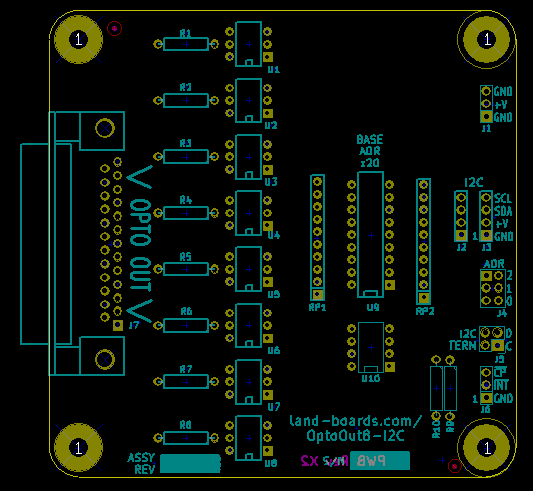
Revision X1
- J5 pin 1 indicator needs to be moved
File:OPTO8-OUT-I2C REV X1
Assembly Sheet
OPTO8-OUT-I2C REV X2 Assembly Sheet















